
On board the MOD70
Following the demise of the ORMA 60 class, so offshore multihull racing is entering a new era – that of the Multi One Design 70. The first example of the new genre, Steve Ravussin’s Race for Water, was launched last week in Lorient.
The MOD70 addresses many of the faults of what in our opinion was the world’s most exciting race boat class. Developed from the likes of Tony Bullimore’s Apricot and Mike Whipp’s Paragon, that ruled the roost in the mid-1980s, so after 20 years of development the ORMA 60 trimarans had become extreme, complicated and expensive. This coincided with the class suffering some catastrophic races, none more so than the 2002 Route du Rhum when of 18 starters only three finished and just one without stopping (although it was argued at the time that the 60+ knot winds they encountered were more than you typically see in a round the world race). The death knoll had sounded for the ORMA 60 and with the class unable to agree on a remedy, so it quietly died.
In its place the MOD70 is a one design, thus development costs are eliminated and running costs dramatically reduced. Because it is a production run – the class intends to build 12 of them (which we believe they will achieve) – and because the boats have most of the interesting ORMA 60 go-faster features, but not all of them, the up-front cost of purchasing one is less. The company running the class are in fact set to lose money on the construction of the first five boats – which have been sold for 2.5 million Euros apiece, while MOD70s nos 6-9 will be 3 million, 10-12 3.4 million. When she was built six years ago the price tag on Groupama 2, the last ORMA 60 trimaran to be built, was around 3.2-3.4 million Euros.
One of the shortcomings of the ORMA 60 was that it was overpowered for its 60ft length and hence was prone to pitchpoling. Pretty much every maxi-multihull built since, from the French giants like Banque Populaire V and Groupama 3, to singlehanders like IDEC and Sodebo, to the AC33 multihulls have addressed this issue by effectively elongating the bows in conjunction with moving the centre of effort of the rig further aft. The new MOD 70 is no different in this respect – she can be thought of as an ORMA 60, but with more bow - her main hull is 70ft long, her floats 65ft, with the genniker and Code 0s now tacked to the hull rather than a bowsprit (as is the case with all the recent big offshore multihulls). The CoE being moved aft is most evident from the location of the mast step relative to the forward cross beam: On ORMA 60s the mast step was on the beam. On all the big offshore multis built since, it is stepped on deck mid-way between the forward beam and the doghouse.
Integral to the concept of the MOD70, alongside her designers VPLP was former ORMA 60 skipper Steve Ravussin, who aside from being skipper of the first boat Race for Water, is also Technical Director of the Class. It was he who originally enticed Marco Simeoni, head of the corporate data processing and information systems company Veltigroup, first into the D35 catamaran circuit and then to provide funding to get the MOD70 circuit off the ground. Simeoni is President of Multi One Design SA.
For the MOD70 Ravussin says they started by working out what they wanted the one design to cost and reverse calculated. In general terms the result is a boat that is 95% as exciting as an ORMA 60, less prone to pitchpoling and with most of the go-faster features of the old boat, minus a ‘trimmer’, the trim tab on daggerboard and the ability to cant the mast fore and aft. The end result is cheaper and will have a substantially longer life span.
The new one design is perhaps best compared with Groupama 2, which as mentioned was the last of the ORMA 60s (read more about her here and our account of racing on her). The MOD70 has the same ‘X’ crossbeam configuration with a third semi-circular beam for the main sheet track attached to the aft beam. While her three transoms are sheer (for no particular reason – there is no length limit like the ORMA 60 had), her bows have the now familiar ‘Dreadnought’ reverse profile. Compared to an ORMA 60 she may be longer, but she also has slightly less beam and less sail area. Her 29m tall rotating wingmast is 1m shorter and can be canted up to weather by +/- 4degrees. As we have written extensively in the past, moving the rig's centre of effort up to weather has a similar effect to that of the retractible curved foils in her floats - these alleviate the downward force on the leeward float, helping to reduce the wetted surface area of that float, but significantly also reduces leeward bow burying. So neatly these features both not only boost performance but also safety, as they lower the risk of pitchpoling.
| Column1 | Groupama 2 | MOD 70 |
| LOA | 18.3m | 21.2m |
| Beam | 18m | 16.8m |
| Draft | 4.5m | 4.5m |
| Mast height | 30m | 29m |
| Mast cant +/- | <5deg | 4deg |
| Sail area upwind | 300sqm | 285sqm |
| Sail area downwind | 426sqm | 400sqm |
| Designer | VPLP/Martin Fischer | VPLP |
| Builders/suppliers | ||
| Main hull | CDK | CDK |
| Beams | Decision | Decision |
| Floats | Gépéto | Multiplast |
| Spars | Lorimar | Lorimar |
| Others | AMCO, Profil Composite, Charlies Capelle | Eligio Re Fraschini (foils) |
| C3 Tech (daggerboard) | ||
| HEOL Composite (rudders) | ||
| Maffioli (running and standing rigging) | ||
| Facnor (deck gear) | ||
| Fischer Connectors (electrics) | ||
| Harken (deck gear) | ||
| B&H (electronics) | ||
| Navtec/Sonafi (hydraulics) |
Compared to the ORMA 60 generation lifting foils, the ones on the MOD70 have slightly more curvature to them and their profile is shorter with more chord and without the hook at the end. They also have plastic chocks in the top of their cases, allowing the foil’s angle of incidence to be adjusted by two degrees.
According to Ravussin, the MOD70, compared to Groupama 2, has 8sqm less mainsail and 20sqm less genniker, but the foretriangle is similar or roughly where the ORMA 60s of the previous generation to her were. The sail wardrobe comprises mainsail, ORC (storm jib), trinquette (staysail), Solent (genoa), genniker and a massive Code 0, which Ravussin says really is only for use in very light winds – it will be dropped in 6 knots. The sails are one design, in taffeta covered 3DL, provided by North France and teams are provided with two complete suits in their first year. Each subsequent year they are allowed an additional suit plus two extra buttons. “All the sails are built for the next year at the same time on the same mould, so there will be no differences,” says Ravussin.
The rotating wingmast, made by nearby Lorimar, was built in carbon fibre without a core (monolithic). Ravussin points out that this is not only cheaper but in the event of a boat capsizing it will damage the boat less. “Before you capsized with the Nomex mast, you broke all the parts of the boats because it floated. With these masts you are safer and you save a lot of money too.”
Rigging, both standing and running, is from Maffioli and the former is primarily Dyneema with some PBO, while the Solent stay is Kevlar. Ravussin says they have avoided carbon partly because of cost but they also want a small amount of give.
With Ravussin we attempt the argument that we have tried on other skippers of post ORMA-era offshore trimarans – that while having longer bows and the CoE further aft may reduce the risk of pitchpoling, it also means crews can drive the boats harder, so aren't they just back to square one? But an odd feature of these boats is that they sail as fast, and occasionally faster, if they are not overcanvassed. Ravussin, who sailed round the world a year ago with Franck Cammas on their successful Jules Verne Trophy attempt, cites the example of Groupama 3 when Cammas sailed her in last year’s Route du Rhum with a shorter rig and reduced sail plan. “When he sailed alone he had good speed with a small mast. I am sure now if you attempt the [west to east] Atlantic record with that mast you could go faster. So less sail = more speed.”
The MOD70’s cockpit layout is somewhere between an ORMA 60 and a maxi trimaran. Formed between the aft beam and the main sheet track beam, the cockpit is elliptical in shape and like the ORMA 60 it has a helmsman’s seat at each corner – half way along the aft crossbeam, the highest point when the boat is heeled. The helmsman has no protection other than the aft beam and there is no screen as some of the ORMA 60s had fitted. However the doghouse is bigger – an idea from the round the world tris, as Ravussin says this was used a lot on Groupama 3 for the standby crew.
The cockpit features twin coffee grinders, which are not only used to haul in sheets/halyards, etc but to drive a rotary pump for the hydraulics (particularly useful for canting the rig between tacks). Hydraulics are also used for the main sheet, via a long ram slung beneath the boom, and for the outhaul.
“Before on the grand prix everyone used to take off the hydraulics for the sheet,” recounts Ravussin. “Now the concept has changed – everyone has the same.”
So there’s nothing on board you can change? “Only what you wear!” quips Ravussin. “It is important for the foreigners - you can buy a boat and it is the same as everyone else. Before no one wants to come into the 60 footer because you have Groupama which is the best and you need to build a new boat every two years.” (This is a popular misconception held in France. In fact there were precious few foreign ORMA 60 campaigns principally because funding couldn’t be found outside of France).
While the MOD70 is mildly detuned compared to the raging ORMA 60, another aim for the new boat is for it to have a long life expectancy, possibly as much as nine years and hence her structure has been substantially beefed up. “The safety co-efficient is 2.4x while on the ORMA it was 2x. And that is everywhere,” says Ravussin. Learning from some of the structural failures that occurred to the ORMA 60s, while the MOD70’s construction is in carbon fibre, all panels where there is a chance of slamming have a foam core, while the rest is Nomex. Ravussin provides the example of the floats where their outboard side is foam, while for the inboard side the core is Nomex.
To monitor the structure there are load cells in the hydraulic rams and at the bow and this data is feed into a black box recorder with the rest of the performance data. “If something breaks I can take the black box and I know the position and I know the state of the waves and the wind so I know the pressure on the structure,” says Ravussin. With the additional structure and the shorter straighter cross beams, it is likely that the MOD70 platform will be stiffer than an ORMA 60s, he believes.
Weight of the MOD70 is 5.7-5.8 tonnes with sails on and 6.3 in race trim, which Ravussin says is about 600kg more than an ORMA 60. If the boat had been built with the same meticulous attention to detail as Groupama 2 (and 3), then you could perhaps save 10% of the weight. As it is Ravussin expects the boat to be flying her main hull in 14-15 knots, not quite like a D35, but then this is an offshore boat and one that’s built to last.
More evidence of cost saving can be seen around the boat - in the tiller, and the complex linkages joining up the three rudders which are in alloy rather than carbon. The rudder on the centre hull kicks up and Ravussin says that this is a safety feature in the event of a collision, which strikes us as odd since the rudder on the main hull is surely already protected by the daggerboard?
The MOD 70 also has no aft water ballast tank, which Ravussin says is because with the longer main hull it is not required and simply represents more weight.
Down below the accommodation is somewhat cramped. Up forward, mercifully close to the neutral pitching point of the boat, are the twin pipecots (the MOD 70 will be sailed offshore by six crew with eight on board for the in port races). Aft of this is a nav area to port. Immediately aft of the carbon fibre step ladder that forms the companionway and which is offset to starboard, is the galley (with an escape hatch on the starboard side) with the media station aft and the head aft of that.
As with most offshore classes, there is discussion about minimising the use of fossil fuels, something that is not only good for performance but also good for the environment. Francis Joyon famously completed his last solo circumnavigation without fossil fuels and allegedly Groupama 3 was delivered back to France from the end of the Route du Rhum with just 3lt of diesel on board. The MOD70s are fitted with 50hp Volvo diesel and their primary function is to enable the boats to negotiate the Panama and Suez canals when they complete their round the world race in 2013 and every third year after. So there is no generator (other than the engine) - when sailing Ravussin says they will be able to satisfy most of their power requirements via twin wind generators. This is an area Ravussin says they are likely to develop in subsequent seasons.
One big question yet to be answered is of course about the MOD70’s performance. More will be known this week when she sails for the first time. While she has less righting moment and a shorter rig and is a bit heavier than an ORMA 60, Ravussin believes she will be out perform her precedessor in 16 knots or more wind. “In 0-12 knots...we don’t know exactly. Maybe with the longer main hull it will be better. But after 2-10 knots, the ORMA 60 would be faster.”
In manoeuvres Ravussin reckons the MOD70 will be similar to the ORMA 60s but without the trim tab on her daggerboard she will typically tack through about 90 degrees while with the trim tab Groupama 2 was typically making 84 degrees between tacks.
The MOD70 is a one design, but Ravussin says that at some point in the future once all 12 are built they might look at turboing or upgrading the boat, but this will be a fleet-wide modification. “Normally I think it is pretty good. There was a lot of development before with the other boats [ORMA 60s].”
The MOD70 has some critics who wonder why a bigger stronger boat wasn’t built that was capable of sailing around the world via the Southern Ocean (the MOD70 has little more freeboard than an ORMA 60). Others feel it was a shame that a solution couldn’t be found for the ORMA class such as the one designer Nigel Irens suggested of having fixed dimensions for the rig and sail plan and opening up the rules as to what went beneath it. For the French are extremely ingenious and there is now no longer any opportunity for development. However the sailing world operates in cycles and the MOD70 is certainly the medicine the post-ORMA era multihull class requires. Given the take-up of boats (more on this tomorrow in our interview with the MOD70 Executive Director Franck David) they seem to have got the formula for the new boat just right.
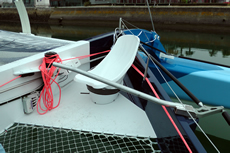 |
 |
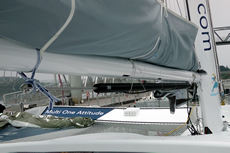 |
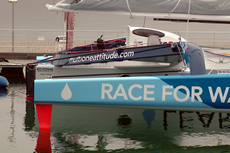 |
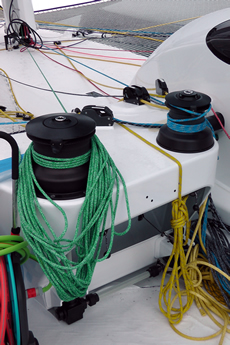 |
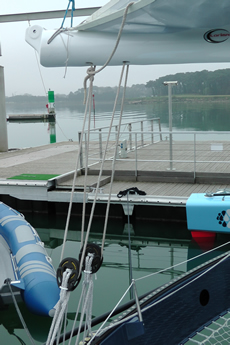 |
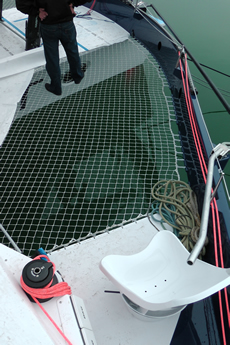 |
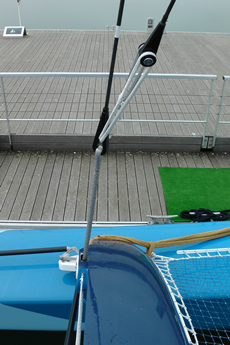 |
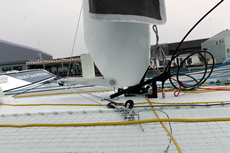 |
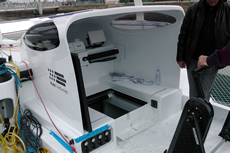 |
 |
 |
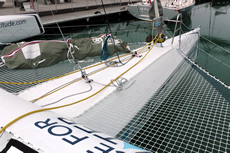 |
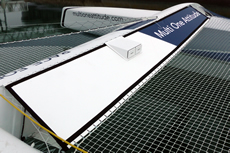 |
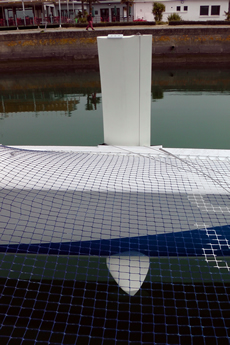 |
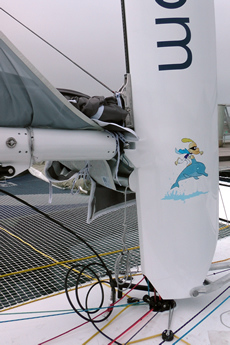 |
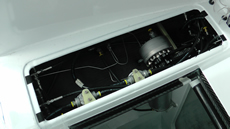 |
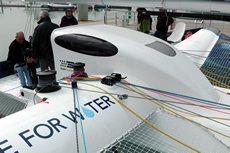 |
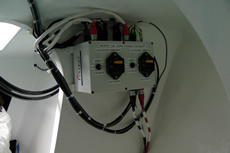 |
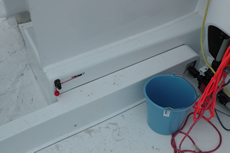 |
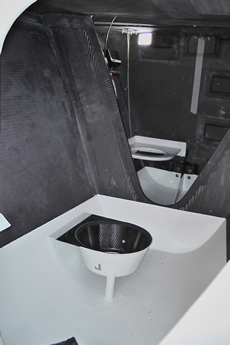 |
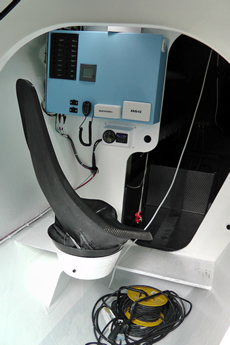 |
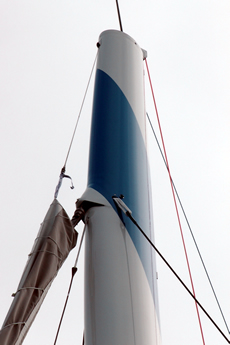 |
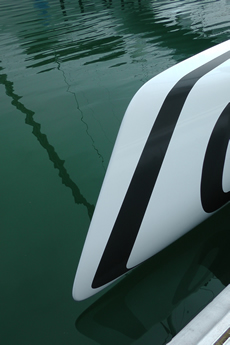 |
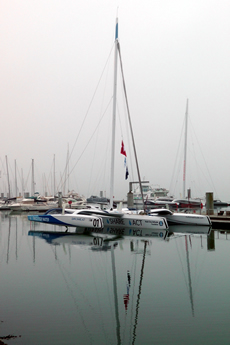 |












Latest Comments
Blackburn 01/04/2011 - 13:16
B&H's new device relays your coordinates by smoke signals, to start it up just apply the tip to any overheated B&G unit... : Pmiles.seddon 01/04/2011 - 11:28
How long have Benson & Hedges been making marine electronics?Add a comment - Members log in